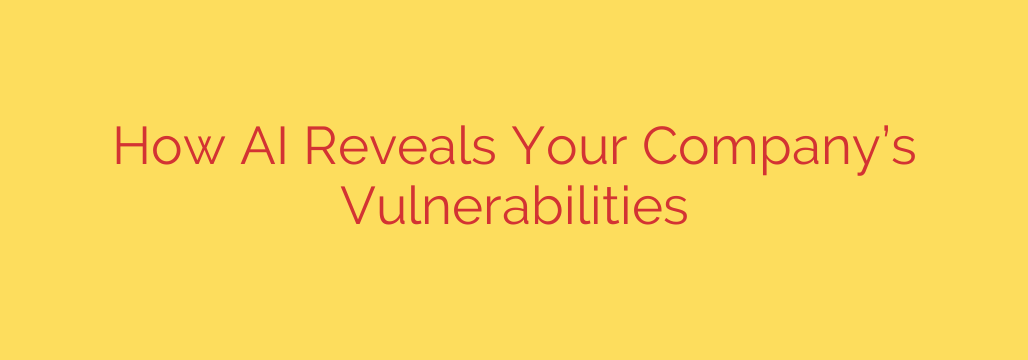
The New Age of Cyber Threats: How AI Uncovers Your Business Vulnerabilities
Artificial intelligence is no longer just a futuristic concept; it’s a powerful tool driving business innovation and efficiency. But as companies embrace AI, so do malicious actors. Cybercriminals are now leveraging the same advanced AI to probe corporate defenses, identify weaknesses, and launch sophisticated attacks with unprecedented speed and scale.
The reality is that AI is actively revealing security vulnerabilities that may have previously gone unnoticed. Understanding how attackers use this technology is the first step toward building a more resilient defense.
The Rise of Offensive AI: A New Breed of Attack
Attackers are weaponizing AI to automate and enhance their methods, turning once-manual hacking processes into highly efficient operations. This new paradigm of “Offensive AI” poses a significant threat to organizations of all sizes.
Here’s how they are doing it:
- Automated Reconnaissance: AI algorithms can sift through vast amounts of public data—from social media profiles and company websites to code repositories on GitHub—in mere seconds. This allows attackers to map out your company’s digital footprint, identify your technology stack, and pinpoint key personnel for social engineering attacks.
- Hyper-Realistic Phishing: Forget the poorly worded emails of the past. Generative AI can now craft highly convincing and personalized phishing attacks that mimic the writing style of executives or trusted colleagues. These messages are context-aware, grammatically perfect, and nearly impossible for the untrained eye to distinguish from legitimate communications.
- Intelligent Vulnerability Scanning: AI-powered tools can probe networks for weaknesses much faster and more thoroughly than human hackers. They can identify unpatched systems, misconfigured cloud services, and weak API endpoints, providing attackers with a detailed roadmap of your most vulnerable entry points.
- Adaptive Malware: The most advanced threats involve AI-driven malware that can change its own code to evade detection by traditional antivirus and security solutions. This type of malware can learn from its environment, identify security measures, and adapt its behavior to remain hidden while exfiltrating data.
Identifying Your Digital Weak Points Before They Do
The same AI capabilities that attackers use can also be a mirror, reflecting your organization’s own security gaps. The key is to see what the AI sees and act first.
Your primary vulnerabilities often lie in three key areas:
Your Public Data Exposure: Every piece of information your company and its employees share online contributes to your digital footprint. AI excels at connecting these disparate dots to build a surprisingly detailed profile. This includes technical details shared in developer forums or publicly exposed code snippets that reveal potential security flaws.
Inconsistent Security Policies: In large organizations, it’s easy for security practices to drift. One department might be diligent about patching, while another lags behind. AI can quickly identify these inconsistencies across your entire network, highlighting servers that haven’t been updated or cloud storage buckets with improper permissions.
The Human Element: Your employees remain a primary target. AI supercharges social engineering, making it easier than ever to trick even savvy users. An AI can analyze an employee’s public LinkedIn profile to craft a spear-phishing email that references their specific role, recent projects, or professional connections, dramatically increasing the attack’s credibility and success rate.
Actionable Security: Strengthening Your Defenses in the AI Era
Fighting AI-powered threats requires a modern, proactive security posture. Standing still is no longer an option. Here are essential steps to protect your organization:
- Adopt AI-Powered Defensive Tools: Fight fire with fire. Implement modern security solutions that use AI and machine learning to detect anomalous behavior, identify sophisticated threats in real-time, and automate incident response. These tools can analyze patterns at a scale no human team can match.
- Conduct AI-Driven Penetration Testing: Use “red team” security services that leverage AI to simulate an attack on your systems. This approach mimics the methods of today’s advanced attackers and provides invaluable insight into your true vulnerabilities before they can be exploited.
- Enhance and Modernize Employee Training: Your security awareness training must evolve. Educate employees specifically on the nature of AI-generated phishing and social engineering. Use simulations that reflect these advanced tactics to build a vigilant and security-conscious culture.
- Prioritize Robust Vulnerability Management: Don’t let known weaknesses linger. Implement a strict and efficient process for identifying, prioritizing, and patching vulnerabilities as soon as they are discovered. Automation and AI can help manage this process across complex IT environments.
- Secure Your Code and Digital Assets: Regularly audit any code or information your company makes public. Implement policies around what can be shared on platforms like GitHub and ensure that sensitive API keys, credentials, or infrastructure details are never exposed.
The cybersecurity landscape is being reshaped by artificial intelligence. While this introduces formidable new threats, it also presents an opportunity to build smarter, faster, and more adaptive defenses. By understanding how AI reveals vulnerabilities, you can take decisive action to secure your assets and protect your organization’s future.
Source: https://www.helpnetsecurity.com/2025/08/01/ai-powered-cyber-threats-video/








